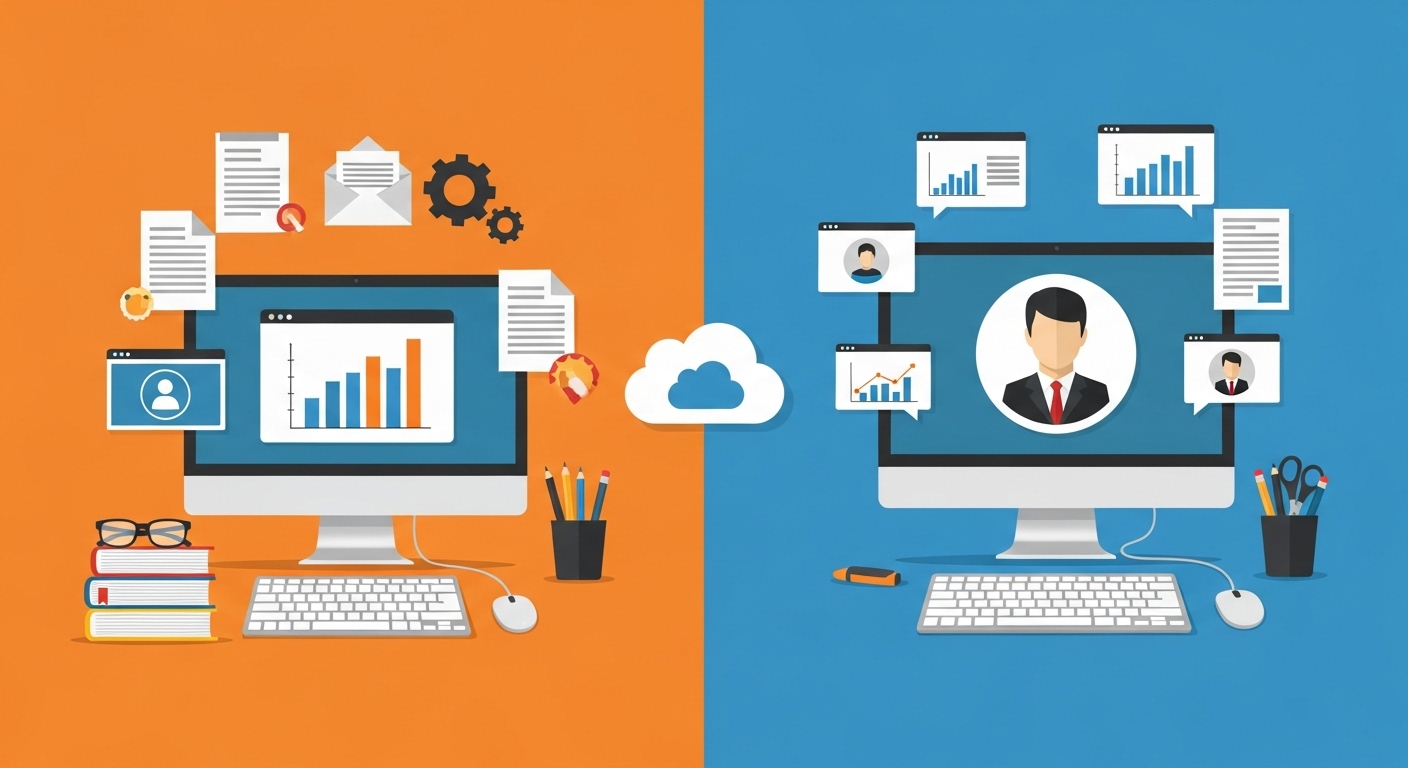If you run an organization in Saudi Arabia and are considering selecting an appropriate management system, understanding the fundamental differences between Desktop Applications and cloud systems—such as the Dism Cloud-based solution—will help you make an informed decision that saves both time and money. Below is a detailed analysis of each aspect, enriched with up-to-date information on ERP systems:
Simplify your workflow and stay compliant with zatca e-invoicing from Daysum.
- Financial Cost
-
Desktop Applications:
- They require a large upfront payment for a perpetual license.
- Additional costs may arise later, including:
- Periodic maintenance fees.
- Charges for upgrading to new versions.
- Expenses related to hosting servers or hiring technical support personnel.
- According to statistics, 57% of companies using desktop applications have encountered unexpected costs due to updates.
-
Dism Cloud-Based Solution:
- There is a fixed monthly or annual subscription fee that covers all services (updates, technical support, and maintenance).
- No sudden financial investments or the purchase of expensive hardware is necessary.
- For example, ERP cloud systems reduce the total cost by 30% compared to on-premise systems.
-
- Update Process
-
Desktop Applications:
- Updates occur irregularly and may require purchasing entirely new versions.
- Some updates might not be compatible with older hardware, forcing you to upgrade.
- For instance, ERP desktop applications typically require an average of 3 months to upgrade to a new version.
-
Dism Cloud-Based Solution:
- Updates are automatic and require no user intervention.
- All users receive the latest version simultaneously.
- Studies indicate that 93% of companies opt for cloud solutions due to the efficiency of their update processes.
-
- Quality of Technical Support
-
Desktop Applications:
- Technical support is limited to the working hours of the developing company.
- On-site visits might be required, potentially disrupting work for several days.
- For example, 40% of small companies experience delays in technical support when using on-premise systems.
-
Dism Cloud-Based Solution:
- Offers round-the-clock technical support via phone or live chat.
- Issues are resolved remotely, ensuring minimal disruption to operations.
- An additional benefit is the provision of detailed reports for each maintenance activity.
-
- Data Accessibility
-
Desktop Applications:
- Access is restricted to devices on which the software is installed or through a complex internal network.
- For example, on-premise ERP systems struggle to support remote work, with 65% facing significant challenges.
-
Dism Cloud-Based Solution:
- Provides secure access from any device (computer, smartphone, or tablet) via a web browser.
- A standout feature of cloud ERP systems is real-time data synchronization across branches, even in different geographical regions.
-
- Scalability and Growth Flexibility
-
Desktop Applications:
- Expanding the system requires purchasing additional licenses or new hardware.
- Specifically for ERP systems, expanding on-premise setups can increase costs by as much as 50%.
-
Dism Cloud-Based Solution:
- Users can be added or removed with a single click.
- The system’s features and functionalities can be expanded seamlessly and without complications.
-
- Security and Protection Measures
-
Desktop Applications:
- The onus of security lies with the organization, including tasks such as data backups and maintaining firewalls.
- Warning: 70% of data loss incidents in on-premise systems are caused by natural disasters.
-
Dism Cloud-Based Solution:
- Data is automatically encrypted, with daily backups stored on multiple servers.
- A key feature of cloud ERP is the use of advanced security measures, such as Two-Factor Authentication.
-
- Performance Speed
-
Desktop Applications:
- Performance is dependent on the device’s specifications (processor, memory, etc.).
- A common issue is that processing large volumes of data can be up to 40% slower compared to cloud-based systems.
-
Dism Cloud-Based Solution:
- Operates on ultra-fast cloud servers.
- For example, cloud systems can process data three times faster than desktop applications.
-
- Integration of Branches and Employees
-
Desktop Applications:
- Connecting different branches typically requires unstable private networks (VPNs).
- A major challenge for ERP systems is that 80% of companies face difficulties synchronizing data across branches.
-
Dism Cloud-Based Solution:
- Operations across multiple branches can be managed from a single control panel.
- An additional advantage is the support for mobile devices without the need for installing additional software.
-
- Handling Hardware Failures
-
Desktop Applications:
- Work stops completely if the server fails.
- In practice, 30% of companies lose an entire day’s work due to hardware malfunctions.
-
Dism Cloud-Based Solution:
- Ensures business continuity through the use of backup servers.
- A notable feature is that the service remains unaffected even if up to 50% of the servers fail.
-
- Technological Development and Future Updates
-
Desktop Applications:
- They may eventually become incompatible with modern technologies after several years.
- Warning: 60% of companies are forced to replace their systems every 5 years.
-
Dism Cloud-Based Solution:
- Provides automatic updates that incorporate technologies such as artificial intelligence (AI).
- For example, cloud systems support big data analytics without incurring additional costs.
-
Conclusion: Why the Dism Cloud-Based Solution is the Smartest Choice
- According to statistics:
- 93% of companies currently use cloud solutions.
- 57% of small organizations save 20% of their budget after transitioning to the cloud.
- In an ERP comparison:
- Cloud ERP systems reduce the overall cost by 35% compared to on-premise software.
- 80% of companies report improved productivity after adopting cloud solutions.
Final Tip: Do not risk choosing a system that might hinder your growth!




